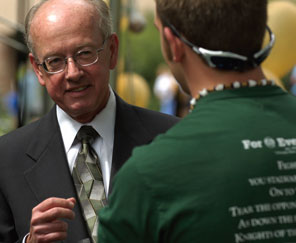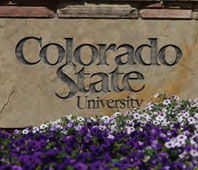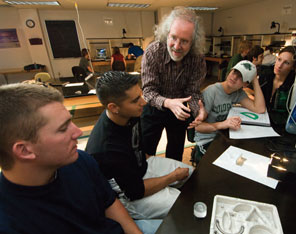Changing Lives for the Better
Worldwide, an estimated 1.6 million people die each year from health problems brought on by toxic air in their homes as they cook family meals over primitive stoves and open pit fires. Millions more suffer health problems — and even death — from vehicle exhaust or tainted water, particularly in underdeveloped countries. And yet, our nation’s research universities have not fully realized their power to change lives for the better. I came to this awareness early in my tenure as president of Colorado State University (CSU), an institution with an impressive research record in nearly every field that touches upon the dilemma called “global sustainability” — from climate change to soil science to human nutrition. Our investigative studies, I realized, were well-aligned with the greatest human and environmental challenges facing our planet. But what was missing were effective systems and processes for moving research solutions out of the laboratory and into the hands’ and homes’ of people whose lives could be transformed. Our academic programs were not maximizing their capacity to prepare students for life and for work in a world where global sustainability will increasingly be a concern of all countries and people.
Inspired by faculty members like Bryan Willson — whose groundbreaking clean engine technology is now helping Filipino taxi drivers earn a living wage — and Barry Beaty — who is on the front lines of fighting infectious disease in the developing world, I challenged our University to do better. The result: a pioneering approach that focuses on successfully deploying research solutions in ways that are affordable, practical and immediately impactful in the fight for global health and well-being.
Global sustainability problems are far-reaching and multifaceted; they encompass environmental responsibility, the need to support healthy people and communities, as well as a healthy planet. Through deployment of ground-breaking research solutions and education of a “green collar” workforce, research universities can have a significant and lasting impact. But as we’ve learned at Colorado State University, to do so requires that we shift our emphasis away from a campus focus to a societal focus and then that we take a broader, more business-oriented approach to “sustainability” than we have before.
It’s Not Enough To Change Light Bulbs

© William A. Cotton/CSU
Concerned individuals and families routinely adopt lifestyle changes to live in greater harmony with the environment, and organizations clearly must do the same. This is particularly true for large, complex institutions like universities that operate massive physical plants and that employ thousands of people. But no matter how many energy-efficient light bulbs we install on our campuses — no matter how sustainable we make our own operations, these modifications alone will not have the major global impact needed to improve people’s lives nor make a difference throughout the world.
Don’t misunderstand: Sustainability efforts on campus are as important as they are for any business or organization. My own institution, Colorado State University in Fort Collins, has long been a leader in campus-based “green” efforts. Our university’s steam turbine generator reduces our CO2 emissions by more than 5.2 million pounds a year. Since 1990 water use on our campus has decreased 22 percent or 180 million gallons. Ours was one of the first universities to offer on-campus residents the option to purchase wind power, and we’re in the process of building a wind farm that will generate more power than the University consumes. Used cooking oil from our dining centers is collected and recycled to create biodiesel. A wetland we’ve constructed on CSU grounds removes pollutants and sediments from water that drains from the campus greenhouse. Our Forest Service nursery produces 2 million seedling trees each year and thereby reduces atmospheric carbon dioxide. All our vending machines are designed to be energy-efficient and decrease carbon dioxide emissions by more than 230,000 pounds per year. And, thanks to our students’ commitment, we just earned second place in the annual U.S. RecycleMania competition.
But such activities, by this point, should be a routine part of doing business responsibly at any large organization. Institutions of higher learning can do so much more. Universities are society’s greatest idea and innovation sources so they should generate fundamental solutions for problems such as climate change while preparing a skilled workforce for anticipated green-industry job demands over the next several decades. To fulfill this goal, universities must be organized so that they have the potential to contribute to economic growth; and the products of their science and engineering research must be commercialized for the greater good. University presidents, in turn, have an obligation to organize their institutions to increase the inherent ability to educate and to develop new ideas and technologies. That is why I have been traveling around the country this year to speak with industry leaders, as well as fellow educators, about Colorado State’s innovative approach to confronting the global sustainability challenge and the need for universities to play a more aggressive role in addressing its different aspects.
A New Approach

© John Eisele/CSU
Colorado State was “green” before “green” was trendy, and it has been home to environmental science world leaders for decades. Our scientists built the world’s first engineered solar-heated and cooled building. We created the nation’s first emissions control center. Our faculty led the most prominent, independent engines research laboratory in North America. And these are only a few examples of our involvement; an initial summary compiled by my office was more than 40 pages long. But today’s elevated national consciousness — our heightened awareness of the virtue in “going green” — creates an environment conducive to expanding these efforts. For that reason Colorado State University has adopted a clear philosophy: Take great research ideas; narrowly focus upon specific areas — such as the problem of carbon-emitting two-stroke engines in Asia — and move them rapidly into the marketplace.
Envirofit International, a CSU spinoff company, provides a powerful example: It is developing what The New York Times calls “the first market-based model for clean-burning wood stove technology” in the developing world and has built a corporate infrastructure to support this model. AVA Solar, a spinoff of CSU Professor W.S. Sampath’s work, is about to begin mass production of solar panels that could cost roughly the same as power from the traditional electrical grid. These projects represent just a few ways that our faculty members are addressing environmental challenges beyond our campus; undergraduate and graduate students are involved in each one.
To support innovative projects like these and to ensure they advance quickly from the laboratory to the real world, we have devised a new method of moving technology to market; it’s called the “Supercluster.” Pairing a multidisciplinary academic research infrastructure with a market-driven business enterprise, “Superclusters” cut through bureaucratic red tape that too often prevents collaboration between universities and the business world. The structure also ensures that faculty members retain some control over how their inventions are deployed while recognizing that successful deployment requires business and investment experts’ working in partnership with research faculty toward a common goal.
The “Supercluster” organization is designed to channel innovative faculty ideas into practical, affordable solutions to global challenges; in the process quality of life improves, and economic prosperity is promoted. Professors Willson’s and Beaty’s work provide excellent examples. To fight infectious diseases like dengue fever, Beaty and his colleagues are devising new types of insecticide-treated mosquito netting that will keep people from becoming infected in their homes. Willson recognized that a single two-stroke engine can generate as much pollution as 50 conventional automobiles so he and his laboratory assistants have designed a simple retrofit for two-stroke engines to make them more efficient and less polluting. For a taxi driver in the Philippines making only $3-5 a day, this retrofit and the resulting energy efficiency mean a big cost savings and more income to feed one’s family.
These types of simple, pragmatic outcomes — grounded in our most advanced science — can save lives worldwide, and Colorado State’s “Supercluster” model provides a dynamic new approach for getting such solutions into the hands of those who need them. In pursuing the “Supercluster” model, we’ve acknowledged that the heart of a great university today is not focused on only teaching, learning and knowledge generation but on the institution’s capacity to take that knowledge and to commercialize it for the greater good by using either a for-profit or not-for-profit enterprise-based business model.
The Green Collar Workforce

© William A. Cotton/CSU
Research activities that form the basis of our “Supercluster” model involve students, both undergraduate and graduate; these scholars are gaining knowledge and skills that will position them to become competitive in tomorrow’s workforce. Universities are only now awakening to the emerging workforce needs — from green-building architects to wind-energy engineers — that our campuses will be called upon to help fill in the coming decades. Studies suggest that the renewable energy industry could create 40 million new U.S. jobs by the year 2030. A recent draft document by the United Nations Environmental Programme notes that, in the United States, the environmental industry generated 10 times more jobs in 2005 than the pharmaceutical industry did. With programs focused upon environmental sustainability and with climate change integrated across the curriculum, Colorado State students are well prepared to be strategically competitive in meeting the surging needs for a highly skilled green-collar workforce. To continue to satisfy this demand will require that we go beyond building sustainability into curricula and that we adopt new educational programs tailored to the demands of this new economy.
At Colorado State we’ve recognized that it’s not enough to change light bulbs in our campus buildings. We ought to focus, instead, upon engineering a better light bulb and upon educating leaders who will invent a replacement for the light bulb. Through research and education, universities like Colorado State can transform lives by generating jobs, by improving health and living conditions for people worldwide, and by stimulating economic prosperity. Those institutions able to incubate innovation and to accelerate the transfer of laboratory research to the free market will succeed in solving global problems. And schools that prepare graduates for work and for service in the emerging “green” economy are planting seeds of solutions for generations to come. While universities must be environmentally responsible as we run our organizations, the greater challenge now is to focus capacity upon more enterprise-based solutions and upon education that will truly make a global difference.




























